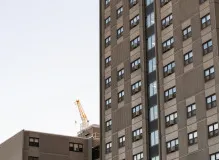For over long years, we have diligently conducted independent research and product testing. When you make a purchase through our links, we may earn a commission.
Act Fast: How to Prevent and Handle Flat Fire Emergencies
Created: 2 weeks ago

17 min Read
Introduction
Fire safety is a critical aspect of ensuring the well-being and security of individuals living in flats and apartment buildings. The risk of fires in these types of dwellings is particularly concerning, as they can spread quickly and have devastating consequences. In this blog post, we will explore the importance of fire safety and highlight the specific risks associated with flat fires. By understanding these risks and implementing preventive measures, you can significantly reduce the likelihood of a fire and protect yourself and your loved ones.
The Risks of Flat Fires
Flat fires pose unique challenges and hazards compared to other types of fires. The close proximity of multiple living units within the same building increases the potential for a fire to spread rapidly. Here are some key risks associated with flat fires:
-
Inadequate Fire Safety Measures: Many older flats may lack modern fire safety installations, such as sprinkler systems or fire-resistant doors. This deficiency increases the vulnerability of occupants in the event of a fire.
-
Limited Escape Routes: Flats often have limited escape routes, such as stairwells, elevators, and balconies. If these routes are compromised during a fire, residents may find it challenging to exit the building safely.
-
Smoke Inhalation: Smoke inhalation is a major cause of injury and death in fires. In flats, smoke can quickly fill common areas, hallways, and stairwells, making it difficult for people to evacuate or for firefighters to enter the building.
-
Electrical Faults: Flat fires can be triggered by electrical faults, such as faulty wiring or overloaded circuits. Aging electrical systems or improper maintenance can increase the likelihood of an electrical fire.
Preventive Measures for Flat Fires
To mitigate the risks associated with flat fires, it is crucial to implement preventive measures. Here are some effective strategies to enhance fire safety in flats:
-
Install Smoke Alarms: Ensure that each flat is equipped with functional smoke alarms. Regularly test and replace batteries to guarantee their effectiveness.
-
Create and Practice an Escape Plan: Develop an escape plan with all residents of the flat. Identify the safest and quickest routes to exit the building and establish a designated meeting point outside.
-
Keep Common Areas Clear: Avoid obstructing hallways, stairwells, or other common areas with personal belongings or other objects. Clear pathways facilitate a quicker and safer evacuation during a fire.
-
Regular Maintenance of Electrical Systems: Hire a qualified electrician to inspect and maintain the electrical systems in your flat. Address any faulty or outdated wiring promptly to minimize the risk of an electrical fire.
-
Educate Residents About Fire Safety: Raise awareness about fire safety through regular communication, such as distributing informational pamphlets or organizing fire safety workshops for residents.
Conclusion
Understanding the specific risks of flat fires and implementing preventive measures is crucial for ensuring the safety and well-being of residents. By prioritizing fire safety in flats, we can mitigate the potential for devastating fires and protect ourselves, our families, and our communities. Stay proactive, be prepared, and prioritize fire safety to create a secure living environment in your flat.
Preemptive Measures: Tips for Preventing Flat Fires
Flat fires can be devastating, but with the right preventive measures in place, you can significantly reduce the risk and protect yourself and your loved ones. Here are some important tips to help you prevent flat fires.
Install Smoke Alarms: 🔥 Ensure that each flat is equipped with functional smoke alarms. Smoke alarms are your first line of defense against fires and can give you crucial early warning. Test smoke alarms regularly and replace batteries as needed to ensure their effectiveness.
Create and Practice an Escape Plan: 🔥 Develop an escape plan with all residents of the flat. Identify the safest and quickest routes to exit the building and establish a designated meeting point outside. Practice the escape plan regularly to ensure everyone knows what to do in case of a fire.
Keep Common Areas Clear: 🔥 Avoid obstructing hallways, stairwells, or other common areas with personal belongings or other objects. Keep these areas clear to facilitate a quicker and safer evacuation during a fire.
Regular Maintenance of Electrical Systems: 🔥 Hire a qualified electrician to inspect and maintain the electrical systems in your flat. Address any faulty or outdated wiring promptly to minimize the risk of an electrical fire. Regular maintenance is essential to ensure the safety of your electrical system.
Educate Residents About Fire Safety: 🔥 Raise awareness about fire safety through regular communication. Distribute informational pamphlets or organize fire safety workshops for residents. Educating everyone in the building about fire safety measures can help prevent fires and save lives.
Taking these preventive measures will significantly enhance fire safety in flats and reduce the risk of flat fires. By being proactive and implementing these tips, you are prioritizing the safety and well-being of yourself and those around you. Remember, prevention is key when it comes to fire safety. Stay vigilant and stay safe!
| Importance | Tips | |
|---|---|---|
| 🔥 | Install Smoke Alarms | - Test alarms regularly <br> - Replace batteries |
| 🔥 | Create and Practice an Escape Plan | - Identify escape routes <br> - Establish meeting points |
| 🔥 | Keep Common Areas Clear | - Avoid obstructing pathways |
| 🔥 | Regular Maintenance of Electrical Systems | - Hire qualified electrician |
| 🔥 | Educate Residents About Fire Safety | - Distribute information <br> - Organize workshops |
Staying Alert: Recognizing Early Warning Signs of a Flat Fire
When it comes to fire safety in flats, being proactive and vigilant is key. By recognizing the early warning signs of a flat fire, you can take immediate action and prevent a small incident from turning into a full-blown catastrophe. Here are some important signs to watch out for:
-
Unusual Smells: If you notice a strong, persistent smell of burning or electrical wiring, it could indicate a potential fire hazard. Don't ignore these odors, as they may be a sign of an underlying issue that needs to be addressed.
-
Frequent Tripped Circuits: If your circuit breaker is constantly tripping or fuses are frequently blowing, it could be a sign of faulty electrical wiring. This can increase the risk of electrical fires, so it's important to have a qualified electrician inspect and fix the issue promptly.
-
Hot Outlets or Switches: If you feel excessive heat when touching outlets or switches, it could be a sign of electrical overload or faulty wiring. This heat can ignite surrounding materials, increasing the risk of a fire. Contact an electrician to investigate the issue and ensure your safety.
-
Sudden Power Surges: Unexpected power surges or fluctuations can be a warning sign of electrical problems. These surges can cause sparks or overheating, which may lead to a fire. Invest in surge protectors and contact an electrician to assess and fix the issue.
-
Flickering Lights: If your lights frequently flicker or dim, it could indicate an electrical issue. Loose connections or faulty wiring can generate heat and pose a fire risk. It's essential to have a professional examine and repair any electrical problems promptly.
Taking Action: What to Do in Case of a Flat Fire
Despite our best efforts to prevent flat fires, emergencies can still occur. Being prepared and knowing how to respond in such situations can make a significant difference in ensuring everyone's safety. Here are some crucial steps to follow in case of a flat fire:
-
Stay Calm and Alert: It's natural to feel panicked, but try to stay calm and focused. This will enable you to think clearly and make informed decisions.
-
Alert Others: Immediately notify everyone in the flat about the fire. Shout, knock on doors, or activate the fire alarms to ensure everyone is aware and can start evacuating.
-
Evacuate Safely: Follow your pre-established escape plan and use the designated escape routes. Avoid elevators, as they can malfunction during a fire. If you encounter smoke, stay low to the ground where the air is less toxic.
-
Close Doors: As you exit each room, close the doors behind you. This helps to contain the fire and slows its spread, giving you and others more time to escape and firefighters more time to respond.
-
Call Emergency Services: Once you are safely outside, call the emergency services and provide them with accurate information about the fire and your location. Ensure that everyone in your flat is accounted for.
Remember, the safety of yourself and others should always be the top priority in a flat fire. By recognizing the early warning signs and knowing how to react, you can help prevent tragedies and ensure the well-being of your community. Stay alert, stay safe!
Taking Immediate Action: Steps to Safely Handle a Flat Fire Emergency
In the event of a flat fire, it is crucial to take immediate action to ensure the safety of yourself and others. By following these steps, you can effectively handle a flat fire emergency and minimize the risk of injury or property damage.
-
Alert Everyone: If you discover a fire in your flat, immediately alert all occupants by shouting "Fire!" This will help ensure that everyone is aware of the danger and can begin evacuating the building.
-
Call Emergency Services: Dial the emergency services number (such as 911) to report the fire. Provide them with accurate information about the location and severity of the fire. Stay on the line until they confirm that help is on the way.
-
Evacuate Safely: If it is safe to do so, gather your family members or flatmates and evacuate the flat. Crawl low under the smoke, as it rises towards the ceiling, and use a cloth to cover your nose and mouth to filter out smoke inhalation.
-
Close Doors: As you exit the flat, close all doors behind you. This will help slow down the spread of the fire and prevent it from reaching other areas of the building.
-
Use Stairwells, Not Elevators: Never use elevators during a fire. Instead, use the stairwells to evacuate the building. Elevators can malfunction and trap you in a dangerous situation.
-
Check for Heat: Before opening any doors, check if they are warm to the touch. If they are, it indicates that the fire is close. In such cases, find an alternative escape route or stay in a room with a window and await help.
-
Stay Low: If you encounter smoke-filled corridors or stairwells, stay as low to the ground as possible. Smoke rises, and the air quality will be better closer to the floor.
-
Do Not Go Back Inside: Once you have safely evacuated, do not re-enter the building under any circumstances. Let the firefighters handle the situation.
-
Follow Emergency Procedures: Familiarize yourself with the emergency procedures outlined by your building management or landlord. Understanding the building's evacuation routes and emergency exits will help you act swiftly during a fire.
-
Meet at a Safe Location: Designate a safe meeting point away from the building where all occupants can gather after evacuating. This will allow you to account for everyone and ensure their safety.
Remember, the priority during a flat fire is your safety and the safety of others. Following these steps can help you handle a flat fire emergency effectively and protect lives.
Essential Fire Safety Equipment Every Flat Should Have
Fire safety is of utmost importance in any residential building, especially in flats. It is crucial to equip your flat with the necessary fire safety equipment to prevent and minimize the risks associated with fires. Here are some essential fire safety equipment that every flat should have:
-
Smoke Alarms: Smoke alarms are a critical component of fire safety in flats. Install smoke alarms in key areas of your flat, such as bedrooms, living rooms, and hallways. Ensure they are functioning properly by regularly testing and replacing the batteries.
-
Fire Extinguishers: Having fire extinguishers readily available in your flat can help you tackle small fires and prevent them from spreading. Place fire extinguishers in easily accessible locations, such as near exits and in the kitchen.
-
Fire Blankets: Fire blankets are highly effective in smothering small fires or wrapping around a person to protect them from flames. Keep a fire blanket in your kitchen, as cooking-related fires are common in flats.
-
Fire Escape Ladders: In case of a fire blocking the main exit, having a fire escape ladder can be a lifesaver. Invest in a sturdy and easy-to-use fire escape ladder that can be attached to a window to provide a safe exit route.
-
Fire Doors: Ensure that your flat has fire-resistant doors installed. Fire doors can help contain the spread of fire, providing valuable time for occupants to evacuate and for firefighters to arrive at the scene.
-
Emergency Lighting: In the event of a power outage during a fire, emergency lighting can guide you to safety. Install emergency lights in common areas, stairwells, and hallways to ensure visibility is not compromised.
-
Fireproof Safe: Protect your important documents, valuables, and sentimental items by storing them in a fireproof safe. A fireproof safe can help safeguard your belongings in case of a fire incident.
Remember, having these fire safety equipment is not enough; regular maintenance and inspections are crucial to ensure they are in optimal working condition. Develop a maintenance schedule and address any issues promptly to keep your flat well-prepared for fire emergencies.
Safeguarding your flat with essential fire safety equipment is a responsible measure that could potentially save lives. Invest in these equipment and educate yourself and your family on their usage. Fire safety should never be taken lightly, and taking these precautions will provide peace of mind knowing that you are prepared to handle any fire emergency that may arise in your flat.
Developing an Emergency Evacuation Plan for Flat Residents
🔥 Flat fire safety is a critical concern for residents living in multi-unit buildings. In the event of a fire, the close proximity of multiple living units within the same building can increase the risk of fire spread. It is crucial for residents to develop and practice an effective emergency evacuation plan to ensure their safety and well-being.
Having a well-defined evacuation plan is essential, as it provides residents with clear instructions on how to exit the building safely and quickly in the event of a fire. Here are some key steps to consider when developing an emergency evacuation plan for flat residents:
-
Identify Escape Routes: Familiarize yourself with the possible escape routes in your building. Take note of the nearest stairwells, elevators, and fire exits. Make sure these routes are not obstructed and are easily accessible.
-
Designate a Meeting Point: Choose a designated meeting point outside the building where all residents can gather after evacuating. This ensures that everyone is accounted for and allows firefighters to quickly assess whether anyone is still inside the building.
-
Communicate and Practice: Share the evacuation plan with all residents in your flat. Clearly communicate the plan, including the designated meeting point, escape routes, and emergency phone numbers. Regularly practice the evacuation plan with everyone in your flat to ensure that everyone knows what to do in case of a fire.
-
Consider Special Needs: Take into account any special needs or limitations of residents in your flat. If someone has mobility issues, ensure that there is a plan in place to assist them during an evacuation. Consider using evacuation chairs or other devices if necessary.
-
Stay Low and Use Fire Extinguishers: In the event of a fire, it is important to stay close to the ground where the air is less smoky and toxic. Teach residents how to properly use fire extinguishers to tackle small fires, if it is safe to do so. Emphasize the importance of calling emergency services before attempting to extinguish a fire.
Remember, preparation is key in ensuring the safety of flat residents during a fire emergency. By developing and practicing an emergency evacuation plan, you can minimize the risks associated with flat fires and protect yourselves and your loved ones.
Comparing Fire Safety Measures in Flats
In order to ensure comprehensive fire safety in flats, it is essential to implement appropriate measures and installations. Let's compare different fire safety measures that can be undertaken in flats:
| Fire Safety Measure | Advantages | Disadvantages |
|---|---|---|
| Smoke Alarms | Early detection of fire and smoke | Batteries need regular testing and replacement |
| Fire-resistant Doors | Slows down the spread of fire and smoke | May be expensive to install and maintain |
| Sprinkler Systems | Automatically extinguish or control fires | Initial installation cost may be high |
| Emergency Lighting | Illuminates exit routes during emergencies | Requires proper maintenance and testing |
| Fire Extinguishers | Immediate access to fire-fighting equipment | Requires proper training and periodic inspection |
These fire safety measures work together to create a safer living environment in flats. It is important to assess the specific needs of your building and consult with fire safety professionals to determine the most appropriate measures to implement.
By implementing a combination of these fire safety measures and regularly maintaining them, flat residents can significantly reduce the risk of fires and increase the chances of a safe evacuation in the event of an emergency.
Note: This is a sample table for demonstration purposes. Please customize the advantages and disadvantages based on the specific fire safety measures applicable to your flat.
The Risks of Flat Fires
Flat fires are a serious concern that can have devastating consequences. The close proximity of multiple living units in the same building increases the potential for rapid fire spread. 🚫 Inadequate Fire Safety Measures: ⚡ Many older flats may lack modern fire safety installations, such as sprinkler systems or fire-resistant doors. This deficiency increases the vulnerability of occupants in the event of a fire.
🚫 Limited Escape Routes: Flats often have limited escape routes, such as stairwells, elevators, and balconies. If these routes are compromised during a fire, residents may find it challenging to exit the building safely.
🚫 Smoke Inhalation: Smoke inhalation is a major cause of injury and death in fires. In flats, smoke can quickly fill common areas, hallways, and stairwells, making it difficult for people to evacuate or for firefighters to enter the building.
🚫 Electrical Faults: Flat fires can be triggered by electrical faults, such as faulty wiring or overloaded circuits. Aging electrical systems or improper maintenance can increase the likelihood of an electrical fire.
To mitigate these risks, it is crucial to implement preventive measures. By taking proactive steps, flat residents can significantly enhance fire safety and protect themselves and their loved ones.
Preventive Measures for Flat Fires
Implementing effective preventive measures can greatly reduce the likelihood of a flat fire. Here are some strategies to enhance fire safety in flats:
1. Install Smoke Alarms: Ensure that each flat is equipped with functional smoke alarms. 🔔 Regularly test and replace batteries to guarantee their effectiveness.
2. Create and Practice an Escape Plan: Develop an escape plan with all residents of the flat. Identify the safest and quickest routes to exit the building and establish a designated meeting point outside. 🔥 Practice the plan regularly to ensure everyone is familiar with the procedure.
3. Keep Common Areas Clear: Avoid obstructing hallways, stairwells, or other common areas with personal belongings or other objects. Clear pathways facilitate a quicker and safer evacuation during a fire. 🔍 Regularly maintain and inspect fire exits to ensure they are accessible at all times.
4. Regular Maintenance of Electrical Systems: Hire a qualified electrician to inspect and maintain the electrical systems in your flat. Address any faulty or outdated wiring promptly to minimize the risk of an electrical fire. ⚡️ Avoid overloading electrical outlets and use surge protectors where necessary.
5. Educate Residents About Fire Safety: Raise awareness about fire safety through regular communication. Distribute informational pamphlets or organize fire safety workshops for residents. 📚 Cover topics such as fire prevention, emergency evacuation procedures, and the proper use of fire extinguishers.
By implementing these preventive measures, flat residents can significantly reduce the risk of fires and ensure the safety and well-being of themselves and their neighbors. Stay proactive and prioritize fire safety in flat communities. Remember, prevention is the key to avoiding flat fires and protecting lives.
Frequently Asked Questions (FAQs)
What are some common causes of flat fires?
Some common causes of flat fires include electrical faults, unattended cooking, smoking indoors, and faulty appliances or wiring.
How can I prevent flat fires?
To prevent flat fires, make sure to regularly check and maintain electrical appliances, avoid smoking indoors, never leave cooking unattended, and install smoke alarms.
What should I do if a flat fire occurs?
If a flat fire occurs, immediately evacuate the flat and call emergency services. Use fire extinguishers if it is safe to do so, and close doors behind you to slow down the spread of fire.
How can I stay safe during a flat fire?
To stay safe during a flat fire, remember to stay low to avoid inhaling smoke, cover your mouth with a wet cloth, and follow the evacuation procedures and instructions given by authorities.
Are there any common mistakes to avoid during a flat fire?
Yes, some common mistakes to avoid during a flat fire include opening doors without checking if they are hot, using elevators instead of stairs, and attempting to extinguish large fires without proper training.
What should I do if someone is trapped inside a burning flat?
If someone is trapped inside a burning flat, you should not attempt to rescue them yourself. Call emergency services and provide them with as much information as possible while waiting for their arrival.
Can I prevent flat fires by using fire-retardant materials?
While using fire-retardant materials can help slow down the spread of fire, it does not guarantee prevention. It is still crucial to follow fire safety measures and be prepared for emergencies.
How often should I check my smoke alarms?
Smoke alarms should be checked once a month to ensure they are functioning properly. It is also recommended to change the batteries at least once a year.
Are fire drills necessary for flat residents?
Yes, fire drills are essential for flat residents to practice evacuation procedures and familiarize themselves with escape routes in case of any emergencies.
Where can I find more information about fire safety?
You can find more information about fire safety from local fire departments, government websites, and organizations dedicated to fire prevention and safety.









